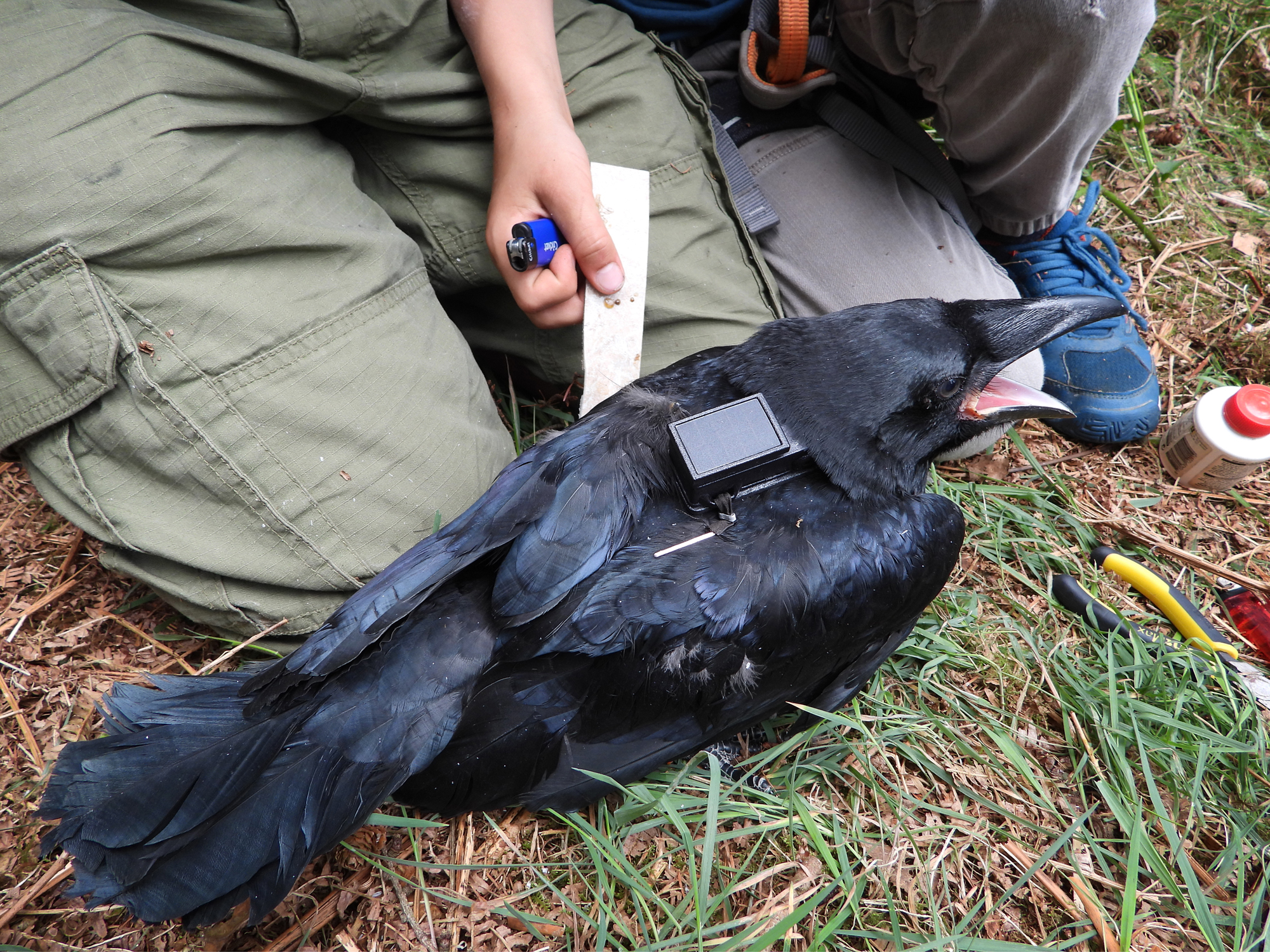Lysanne Snijders, a researcher at the behavioural ecology group (Animal Sciences), has been awarded a so-called Dobberke Grant. This will enable her to buy five additional transmitters for her raven study, which will yield a considerable increase in data for the dataset on the behaviour of this bird species that once was almost extinct in the Netherlands.
Snijders studies the raven’s food strategies on the Veluwe. She conducts her research in close collaboration with the ARK Foundation for Nature Development, the Dutch Raven Workgroup and Sovon Bird Research. These organisations have fitted ravens with tiny GPS transmitters since 2021. Initially, the transmitters were used to see whether ravens benefitted from the return of the wolf in the Netherlands since the wolf supplies the birds with carrion. But the transmitters yielded much more interesting data.
The information gathered showed that the birds do not forage exclusively near carcases but that they also access food sources created by humans, such as trash cans near fast food restaurants or landfills, even on the Veluwe, where there is a relatively large supply of natural food. This is the result of carrion left behind by wolf packs, as well as roadkill, which is frequently recycled, Snijders states.
Neophobe
The desire for human food sources is remarkable in an environment that is rich in natural food sources. Particularly since ravens are neophobic: they fear the unknown. Snijders: ‘Seeing a naturally wary animal display this behaviour is interesting. Apparently, they have learned that there is nothing to fear. But how did they discover this? Through interacting with the environment? By mimicking cospecies?’
The raven’s food choices raised many questions. Why are some ravens more frequently found near human food sources than others? How do they adopt this foraging strategy? Do they mimic their parents, or is the foraging strategy of the youth group in which young birds seek each other’s company a critical factor? And, will their individual preferences persist through time or will their food strategy become more opportunistic once they acquire their own territory in adulthood? Will that cause them to eat whatever they can get? And, are there differences between the sexes?
Sample size
A larger sample size is invaluable for greater insight into these mechanisms. At present, 21 ravens have been tagged on the Veluwe, with eight GPS transmitters still in operation. Of these eight, two have provided data since 2021. Thanks to the grant, Snijders will be able to increase this total by at least five, a 25 per cent increase. The ravens, from different nests and different locations on the Veluwe, will be tagged by specialised volunteers from the Dutch Raven Workgroup. The additional transmitters will be placed as early as this breeding season.
The transmitters weigh no more than three per cent of a raven’s body weight. The minute battery and solar cell (which provides energy for the data) are attached to the young ravens with a harness while the young bird is still in the nest at the age of five to six weeks. This enables them to learn to fly and operate with the harness from an early age. When the tag is fitted, the volunteers also remove a few feathers from the bird’s neck, which later serve to determine the bird’s sex through its DNA. ‘The young birds have no distinguishing visible characteristics that enable you to determine their sex. However, it may be relevant to establish whether male and female ravens develop different (foraging) behaviour’, Snijders explains.
Patience
The data from the transmitters are available in real-time, with some variations owing to the seasons. ‘In the dead of winter, the solar cell generates very little energy, resulting in low battery levels. The transmission frequency of data is automatically reduced’, Snijders clarifies.
She cautions that it may take some time before the new transmitters provide useful data. ‘It takes about six months before the young birds start showing individual behaviour. Ravens leave the nest after three months. But the initial data will provide a basis for type-analyses.’
Snijders is outspoken on the usefulness and necessity of the study. ‘From a fundamental perspective, unravelling how social processes in relation to finding food sources work is very interesting. In terms of application, we can learn how to adapt our human-dominated living environment to better suit the needs of these and other animals.’
Dobberke Grant: 4 times WUR
The Dobberke Grant is a fund coordinated by the KNAW (Royal Netherlands Academy for Arts and Sciences). The grants focus on research into animal behaviour. In addition to Snijders, another three Wageningen scientists saw their application approved:
– Davide Bottacini: Can a conspicuous predator camouflage through background matching?
– Chris Tyson: Coping strategies: understanding how individuals respond to uncertainty.
– Evy Gobbens: Unravelling the diet of multiple shorebird species in a threatened ecosystem using DNA-Metabarcoding.

 Twenty-one ravens have already been tagged on the Veluwe. Tags are fitted by specialised volunteers. Photo Marielle van Uitert
Twenty-one ravens have already been tagged on the Veluwe. Tags are fitted by specialised volunteers. Photo Marielle van Uitert